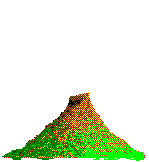


The name "Volcano" is originally
named after "Vulcano", an Italian Island north of Sicily. Volcano is a
cone which is formed above and around a vent by accumulations of erupted
volcanic materials such as ash, pumice, lava flows and other volcanic rocks.
A volcano constitutes a vent, crater and a cone. The vent of the volcano
is an opening at the earths surface. The pipe is a passage way in the volcano
in which the magma rises through to the surface during an eruption.
The crater is a bowl shaped depression at the top of the volcano where
volcanic materials like ash, lava, and other materials are released. Solidified
lava, ashes, and cinder form the cone. Layers of lava, alternate with layers
of ash to build the steep sided cone higher and higher. Since volcanoes
erupt different from each other, depending on the kind of rising magma
as well as other factors. However, most of the volcanic eruptions take
place unseen on the ocean floor. Therefor they are called submarine eruptions.
The sudden violence of volcanic eruptions causes catastrophe and devastation.
Various notorious eruptions of volcanoes in the past such as Mount Pelee,
Tambora, Krakatu and Pinatubo have demonstrated the devastating impact
of volcanic activity on nearby landscapes and communities. Volcanoes are
not randomly distributed over the Earth's surface. Most are concentrated
on the edges of continents, along island chains, or beneath the sea forming
long mountain ranges. More than half of the world's active volcanoes above
sea level encircle the Pacific Ocean to form the circum-Pacific "Ring of
Fire." In the past 25 years, scientists have developed a theory called
plate tectonics, that explains the locations of volcanoes and their relationship
to other large scale geologic features.
Mount Shasta
Shasta, California is the
second highest mountain in the Cascade Range. The volcano is composed of
four overlapping andesite eruptive centers all visible in the photograph.
The oldest center in the Sargents Ridge cone, located on the strongly eroded
lower slopes of Shasta, was active about 450,000 years ago.
Misery Hill, on the northwest
flank of Shastam was active around 9,200 years ago. The Hotlum cone is
the youngest eruptive center and forms Shasta's summit and the north and
the northeast flanks. Hotlum cone was active only a few centuries ago.
Click here
for this information.
Maui and Kahoolawe
The island of Maui is made
of two volcanoes. A central caldera has been identified roughly in the
area of the present day Iao Valley. Alkalic basalt's capped the volcano
about 1.2 million years ago. Kahoolawe is made of tholeiitic and alkalic
basalt of the shield and capping stages. A rock from the capping stage
has been dated at about 1 million years old. During the rejuvenated
stage a small number of eruptions occurred near the Kanapou Bay. The age
of the rocks are unknown.
Click here
for this information.
Volcano Hazards
A volcanic
hazard refers to the probability that a given area will be affected by
a potentially destructive volcanic process. A volcanic risk is a loss in
the hazardous area. Any area near an active volcano is potentially hazardous.
Some areas have higher probabilities of being affected by a destructive
volcanic process than others. a home built near the summit of a volcano
may have the same level risk as one built in a valley 60 km from the volcano.
Click here
for more information on Hazards of Volcanoes.
Causes of Eruptions.
Deep in
the Earth it is so hot that some rocks slowly mely and become a thick flowing
substance called magma. Because it is lighter than the solid rock around
it, magma rises and collects in magma chambers. Eventually some of the
magma pushes through vents and fissures in the Earths surface. Magma that
has erupted out of the volcano is called lava. How explosive an eruption
is depends on how runny or sticky the magma is. If magma is thin runny,
gases can escape easily from it. Lava flows rarely kill people because
they move slowly enough for people to get out of the way.
For more information click
here.
Signs that an eruption is likely.
Most volcanoes provided various
types of warnings before eruptions can occur. Although an explosive eruption
could occur without warning, some premonitory events more likely will precede
the next eruption. People living near volcanoes may detect premonitory
events before an eruption. Both the frequency of occurrences and intensity
of felt earthquakes commonly increase before eruptions begin.
For more information click
here.
For more information on any
of the above click here.
